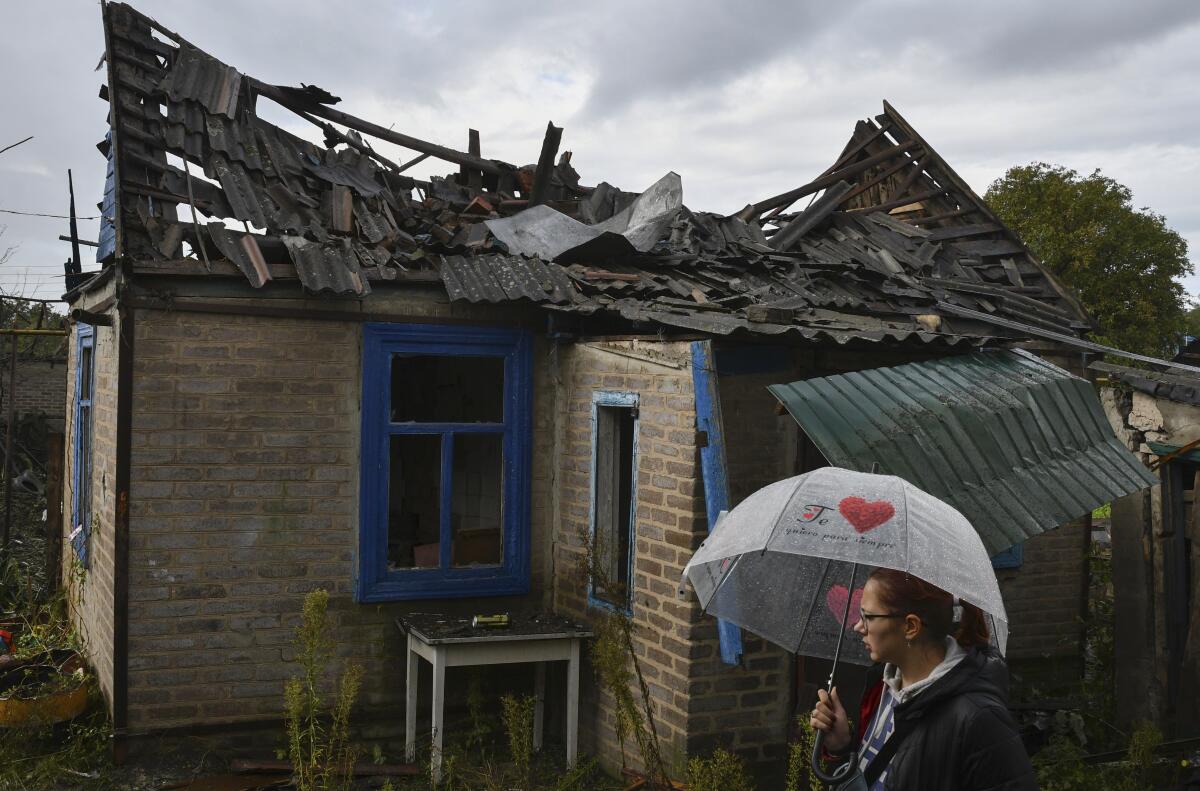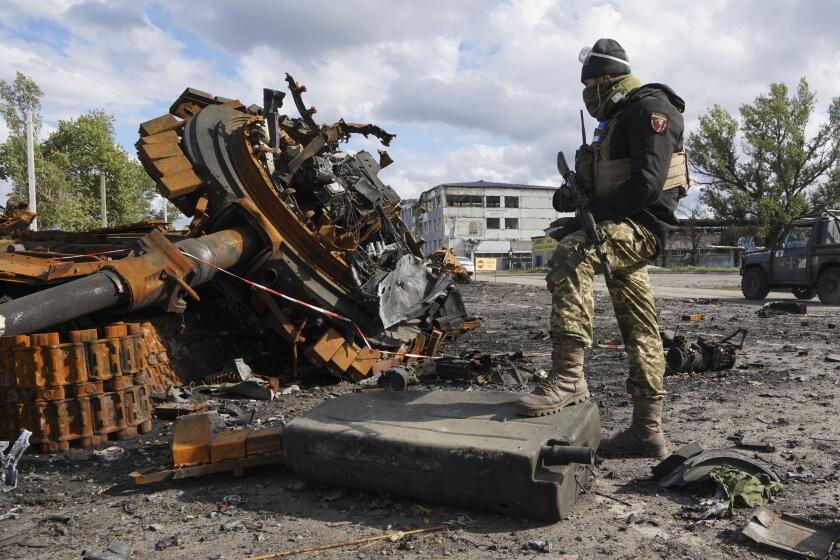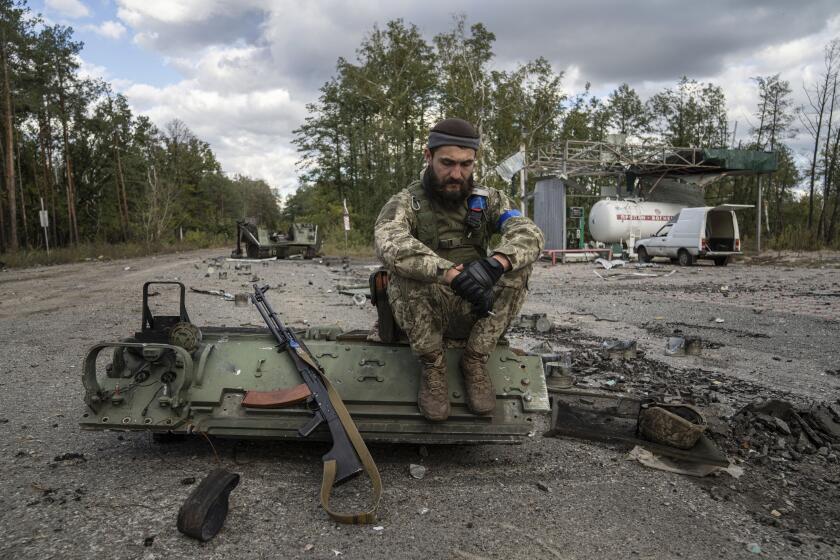Putin signs laws annexing four Ukrainian regions despite battlefield losses

- Share via
KYIV, Ukraine — Russian President Vladimir Putin signed the final papers Wednesday to annex four regions of Ukraine while his military struggled to control the new territory that was added in violation of international law.
Ukrainian law enforcement officials, meanwhile, reported discovering more evidence of torture and killings in areas retaken from Russian forces.
The documents finalizing the annexation were published on a Russian government website Wednesday morning. In a defiant move, the Kremlin held the door open for further land grabs in Ukraine.
Speaking in a conference call with reporters, Kremlin spokesman Dmitry Peskov said that “certain territories will be reclaimed, and we will keep consulting residents who would be eager to embrace Russia.”
Peskov did not specify which additional Ukrainian territories Moscow is eyeing, and he wouldn’t say if the Kremlin planned to organize more such “referendums.”
Putin last week signed treaties that purport to absorb Ukraine’s Donetsk, Luhansk, Kherson and Zaporizhzhia regions into Russia. The move followed Kremlin-orchestrated plebiscite in Ukraine that the Ukrainian government and the West have dismissed as illegitimate.
As Russia’s military performance weakens, a notorious mercenary group, long part of the Ukraine fight, steps into spotlight.
The Russian president defended the validity of the vote, saying it’s “more than convincing” and “absolutely transparent and not subject to any doubt.”
“This is objective data on people’s mood,” Putin said Wednesday at an event dedicated to teachers, adding that he was pleasantly “surprised” by the results.
Putin also signed a decree Wednesday declaring that Russia was taking over the Zaporizhzhia nuclear power plant, the largest in Europe. Ukraine’s Foreign Ministry called it a criminal act and said it considered Putin’s decree “null and void.” The state nuclear operator said it would continue to operate the plant, which was occupied by Russian forces early in the war.
On the ground, Russia faces mounting setbacks, with Ukrainian forces retaking more and more land in the east and in the south — the very regions Moscow now insists are its own.
The borders of the territories Russia is claiming to incorporate remain unclear, but Putin has vowed to defend Russian territory — including the newly absorbed regions — with any means at its disposal, including nuclear weapons.
The head of Ukrainian President Volodymyr Zelensky’s office, Andriy Yermak, wrote on his Telegram channel shortly after Putin signed the annexation documents that “the worthless decisions of the terrorist country [Russia] are not worth the paper they are signed on.
“A collective insane asylum can continue to live in a fictional world,” he added.
Zelensky responded to the annexation by announcing a fast-track application to join NATOand formally ruling out talks with Russia. Zelensky’s decree, released Tuesday, declares that holding negotiations with Putin has become impossible after his decision to take over the four regions of Ukraine.
Bodies of Russian soldiers lie in the streets of Lyman after their comrades’ retreat from the city, the latest in a series of setbacks for Moscow.
In the eastern Kharkiv region, more disturbing images emerged from areas recently reclaimed from Russia.
Serhiy Bolvinov, who heads the investigative department of the national police in the region, said authorities are investigating an alleged Russian torture chamber in the village of Pisky-Radkivski.
He posted an image of a box of what appeared to be precious metal teeth and dentures presumably extracted from those held at the site. The authenticity of the photo could not be confirmed.
Ukraine’s prosecutor general also spoke of new evidence of torture and killings found Wednesday in the Kharkiv region.
Andriy Kostin told the Associated Press on the sidelines of a security conference in Warsaw that he had just been notified of four bodies found with signs of possible torture. He said they were believed to be civilians but an investigation was still needed.
Two bodies were found in a factory in Kupiansk with their hands bound behind their backs, while two other bodies were found in Novoplatonivka, their hands linked by handcuffs.
During his public speech, Kostin said officials found the bodies of 24 civilians, including 13 children and one pregnant woman, who had been killed in six cars near Kupiansk. It was not clear when the discovery was made.
On the battlefield, Russia and Ukraine gave conflicting assessments of a Ukrainian counteroffensive in the Russian-occupied southern Kherson region. A Moscow-installed regional official insisted that Ukrainian advances had been halted.
“As of this morning ... there are no movements” by Kyiv’s forces, Kirill Stremousov said Wednesday in comments to state-run Russian news agency RIA Novosti. He vowed the Ukrainian fighters would not enter the city of Kherson.
Putin’s desperation over humiliating military losses in his war on Ukraine could lead Moscow to back terror attacks against Western countries.
However, the Ukrainian military said the Ukrainian flag had been raised above seven Kherson region villages previously occupied by the Russians. The closest of the liberated villages to the city of Kherson is Davydiv Brid, some 60 miles away.
The deputy head of the Ukrainian regional government, Yurii Sobolevskyi, said military hospitals were full of wounded Russian soldiers and that Russian military medics lacked supplies. Once they are stabilized, Russian soldiers are being sent to Crimea, which Russia annexed from Ukraine in 2014.
“Not everyone arrives,” Sobolevskyi wrote.
In the neighboring Mykolaiv region, the governor said Russian troops have started to withdraw from Snihurivka, a city of 12,000 that Moscow seized early in the war and annexed along with the Kherson region. A Russian-installed official in Snihurivka, Yury Barbashov, denied that Russian troops had lost control of the city, a strategic railway hub, but said the Ukrainian forces were advancing.
Russian state-run media outlets that typically enthuse about Moscow’s war in Ukraine sang a different tune after the loss of a key Ukrainian city.
In the Moscow-annexed eastern Donetsk region, where Ukrainian forces still control some areas, Russian forces shelled eight towns and villages, the Ukrainian presidential office said.
After reclaiming the Donetsk city of Sviatohirsk, Ukrainian forces located a burial ground for civilians and found the bodies of four people, according to Gov. Pavlo Kyrylenko.
In the Luhansk region, also in the eastern Donbas, Gov. Serhiy Haidai said Ukrainian forces have retaken six villages. He did not name the villages, but said the retreating Russian forces are mining the roads and buildings.
Haidai also said that Russian forces were indiscriminately drafting men from the Luhansk region. “They no longer ask about health and marital status; sick people and those with many children are being taken away,” he said.
In central Ukraine, multiple explosions rocked Bila Tserkva, a city about 50 miles south of the capital, Kyiv. Regional leader Oleksiy Kuleba said six Iranian-made Shahed-136 drones struck the city and set off fires at what he described as infrastructure facilities. One person was wounded.
Russia has increasingly been using suicide drones in recent weeks, posing a new challenge to Ukrainian defenses. The unmanned vehicles can stay aloft for long periods of time before diving onto their targets and detonating their payload at the last moment.
Many of the earlier attacks by the Iranian-made drones happened in the south of the country and not near the capital, which hasn’t been targeted for weeks.
More to Read
Sign up for Essential California
The most important California stories and recommendations in your inbox every morning.
You may occasionally receive promotional content from the Los Angeles Times.















